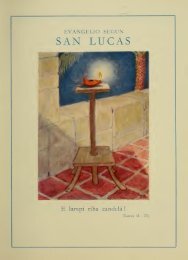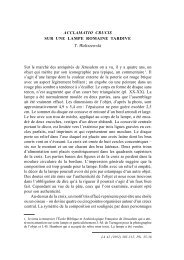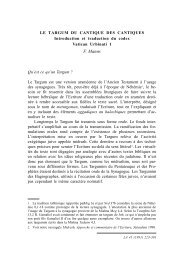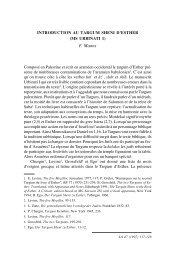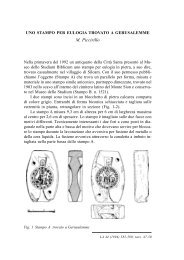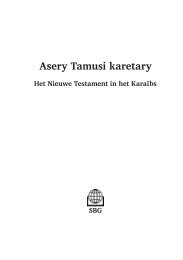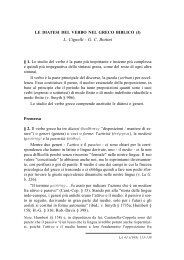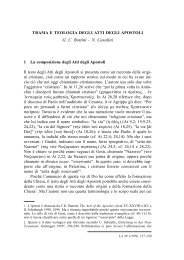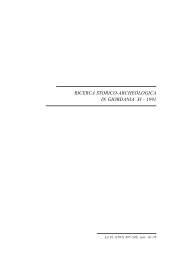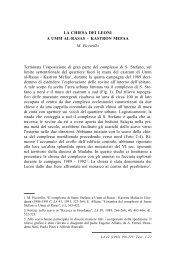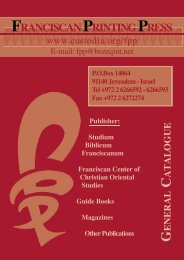Literary Criticism and Theology of P - Christus Rex
Literary Criticism and Theology of P - Christus Rex
Literary Criticism and Theology of P - Christus Rex
You also want an ePaper? Increase the reach of your titles
YUMPU automatically turns print PDFs into web optimized ePapers that Google loves.
12<br />
E. CORTESE<br />
31,1.12) begins, endorsing the impression <strong>of</strong> a new intervening redaction.<br />
As for the last object, the laver <strong>of</strong> brass (30,17-21), one has to take note <strong>of</strong><br />
the lack <strong>of</strong> a description similar to that <strong>of</strong> the former objects.<br />
2. Apart from the above classical literary critical conception, we must<br />
discuss the problem <strong>of</strong> the ark which commences from Ex 25. Here we<br />
defend the substantial attribution <strong>of</strong> 25,10ff. to Pg (against Weimar), except<br />
the passage on the kappôret (following de Tarragon).<br />
2a. The empty tent proposed by P. Weimar is not acceptable. Pg<br />
presents a tent which has clearly the form <strong>of</strong> the temple. Note the wooden<br />
boards (26,15) <strong>and</strong> the internal veil (paroket, 26,31ff.) subdividing it in two<br />
parts. Since Pg maintains the intention <strong>of</strong> connecting the tent with the<br />
Jerusalem temple, it cannot exclude from it the most sacred object, on<br />
which the whole monarchic temple <strong>and</strong> cult were centered. According to<br />
the old tradition David recovered the ark <strong>and</strong> brought it into Jerusalem, his<br />
political <strong>and</strong> religious center. P cannot have excluded from its ideological<br />
reconstruction such a central object. It is worth noting that only for the ark<br />
there is the prescription that the shafts have to be constantly kept in the<br />
rings (25,15), echoing the old procession practice!<br />
Consequently the ‘edût inside the ark (25,16.21) cannot be excluded<br />
from the project <strong>of</strong> Pg. The tables <strong>of</strong> the comm<strong>and</strong>ments are central in the<br />
dtr parallel description in Deut 10,1-5. Moreover in 1Kgs 6,19 the Dtr calls<br />
the ark ‘arôn berît, an expression which is parallel to the priestly ‘aron -<br />
ha‘edût. Besides, one <strong>of</strong> the P denominations <strong>of</strong> the tent,’ohel mo‘ed<br />
(29,44), seems echoing this theology (although deriving from y‘d - to meet,<br />
<strong>and</strong> not from ‘wd - to warn or to testify) in a text, which is central to Pg<br />
according to all the recent studies.<br />
2b. On the other h<strong>and</strong> I follow de Tarragon in considering the kappôret<br />
a later addition 13 . A literary critical examination <strong>of</strong> Ex 25,10ff. evidences<br />
moreover the strange double order to put the ‘edût into the ark (16 <strong>and</strong><br />
21b); <strong>and</strong> the order in 21b seems a little absurd, after 21a: the kappôret<br />
already on the top <strong>of</strong> the ark. Together with the kappôret, the cherubins<br />
(25,18ff.), as attached to the kappôret, are also Ps. That there is no kappôret<br />
on the ark in 1Kgs 6, <strong>and</strong> in the whole dtr literature strengthens our<br />
conclusion. In Kgs 6 the (separated!) cherubins are emphazised, as well as<br />
the molten sea in 1Kgs 7,23-40. Also the incense altar seems to be there<br />
(6,22).<br />
13. J.-M. de Tarragon, “La kapporet est-elle une fiction ou un élément du culte tardif?”, RB<br />
88 (1981) 5-12. See my article in RB 104 (1997) 338-353.




